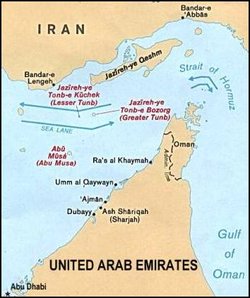Strait of Hormuz
|
|
The Strait of Hormuz (تنگه هرمز in Persian) is a relatively narrow stretch of ocean between the Gulf of Oman in the southeast and the Persian Gulf in the southwest. On the north coast is Iran and on the south coast is the United Arab Emirates and an enclave of Oman.
| Contents |
Strategic position of the islands
Near the north coast are a few islands, which include, Kish, Qeshm, Abu Musa and the Greater and Lesser Tunbs. These islands have great strategic positions functioning as platforms for monitoring the marine traffic.
In a press conference on December 18, 1997, Iranian deputy Foreign Minister Abbas Maleki said that Iran supported the free flow of oil through the Strait of Hormuz, but reserved the option of closing off the shipping route if it is threatened.
Etymology
The opening to the Persian Gulf was described, but not given a name, in the Periplus of the Erythraean Sea, a 1st-century mariner's guide:
- Ch.35. At the upper end of these Calaei islands is a range of mountains called Calon, and there follows not far beyond, the mouth of the Persian Gulf, where there is much diving for the pearl-mussel. To the left of the straits are great mountains called Asabon, and to the right there rises in full view another round and high mountain called Semiramis; between them the passage across the strait is about six hundred stadia; beyond which that very great and broad sea, the Persian Gulf, reaches far into the interior. At the upper end of this Gulf there is a market-town designated by law called Apologus, situated near Charax Spasini and the River Euphrates.
There are two opinions about the etymology of this name. In popular belief the derivation is from the name of the Persian God هرمز Hormoz (a variant of Ahura Mazda). Compare the Pillars of Hercules at the entrance to the Mediterranean. Others namely scholars, historians and linguists derive the name "Ormuz" from the local Persian word هورمغ Hur-mogh meaning datepalm. Actually in the local dialects of Hurmoz and Minab this strait is still called Hurmogh and has the abovementioned meaning.
Air tragedy
On July 3, 1988, the Strait of Hormuz was site of one of the most controversial tragedies in aviation history: Iran Air Flight 655, an Airbus A300 medium-sized passenger jet was shot down by the United States Navy cruiser, USS Vincennes (CG-49). All 290 on board (including 66 children) were killed, while Commander Rogers, the Vincennes' captain, was awarded (by George H. W. Bush in 1990) the Legion of Merit award. An international situation was barely avoided, as the American president George H. W. Bush said "I will never apologise for what Americans do", the Iranian president vowed revenge on the Americans. There is still lingering controversy about the events of this tragedy.
See also: List of islands of Iran
External links
- Strait of Hormuz website: (http://www.dataxinfo.com/index.htm) includes antique maps
- Federation of American Science about the weapons on the islands (http://www.fas.org/nuke/guide/iran/facility/abu-musa.htm)ar:هرمز
da:Hormuzstrædet de:Straße von Hormuz et:Hormuze väin he:מצר הורמוז ja:ホルムズ海峡 nl:Straat van Hormuz pl:Ormuz (cieśnina) pt:Estreito de Ormuz


